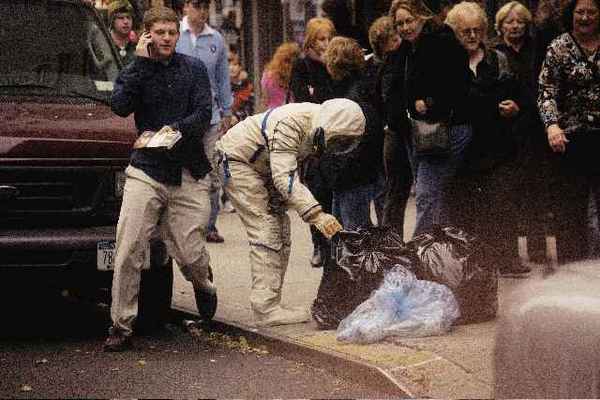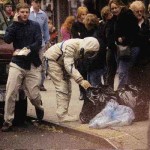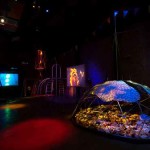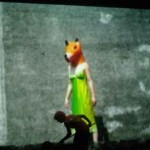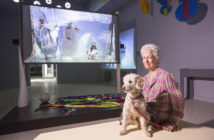Performa, the New York-based performance art biennale, had its third iteration in November. Performa's founding director and curator is RoseLee Goldberg, who in 1979 published the first, now seminal, history of performance art. This monograph takes Italian Futurism as the commencement of performance art, and Performa 09 coincided with the centenary of the publication of F.T. Marnetti's Futurist Manifesto.
At the Italian Cultural Council, Futurist Manifestos contained a collection of archival documents and Feminist Futures displayed primarily photographs relating to Valentine de Saint-Point's engagement with Italian Futurism and subsequent critique of its imperialist tendencies. Both exhibitions would have benefited much from collections guides. The Swiss Institute housed a Futurism Library, amusing in that the library's large cylindrical bookshelf held only a few identical course readers containing photocopied primary texts on primarily Italian Futurism. Stepping east from the Italian movement, Mannequins' Ball at Martin E. Segal Theatre Center offered portions of Bruno Jasieński's eponymous play. The evening followed the Variety Theater pattern of Italian Futurism, with two "viral agents" interrupting the production with proclamations against conformity in the manner of F.T. Marinetti or Ardengo Soffici. Jasieński did write several texts integral to Polish Futurism, but renounced the movement in the mid-1920s in favor of a Trotsky-supported Marxism and social realism. Jasieński's play is from 1931, and setting a social realist work as futurist is misleading while the staging encouraged the dominance of the Italian context.
More successful was the techno-utopianism of Alicia Framis. For 15 consecutive days Framis became Lost Astronaut, who left BaseCamp (Lab APF) dressed as a 1970s female cosmonaut to perform in the urban environment instructions written by various authors. The day we followed her she disappointed us by breaking her role to inquire after shots by photographers documenting her performance. Nevertheless, the mental image of aged white suit before the New York State Insurance Fund's aged white facade engendered an effective nostalgia for the mid-century myth of functionality--a theme Framis also explores in her models for moon architecture.
Three of the strongest works we experienced had little connection to futurism. A Voyage of Growth and Discovery at SculptureCenter is the first collaboration between Mike Kelley and Michael Smith. It takes Smith's character Baby IKKI as locus through which to access tensions concerning the infantile or transgress position of Burning Man, a self-described "community dedicated to radical self-expression and radical self-reliance." A six-channel, two-and-a-half hour video showed Baby IKKI in white bonnet and droopy diaper consuming candy, playing with matches, and lurching on toddler legs amidst the temporary structures and flamboyant attendees of the festival. The six screens were installed among jungle gym bars, an ill-formed geodesic dome over a carpeting of stuffed animals, and a 30-foot sculpture of a baby pointing towards the sky, suggesting the festival's physical remnants and the ideological detritus of modernist bourgeois radicalism. The four screens which displayed Baby IKKI's interactions with revelers evidence the strength of A Voyage as a complicated investigation of assumed notions of individualism and independence.
While A Voyage is readily grasped without wall text, the same cannot be said of Stuart Sherman: Nothing Up My Sleeve at Participant, Inc. Curator and artist Jonathan Berger deploys the efforts of little-known Sherman as a means to consider works that deploy deception and the subjective bases of truth and untruth. The show pivots on objects ranging from photos of Harry Houdini, letters from Vaginal Davis, drawings from Superstudio, and a selection of Andy Kaufman's record collection. But while these artists often beguile to activate alternative realities, in speaking to Berger he revealed that his research for the show was an attempt to find his "family," the artists--many of whom were local to his growing up in New York--and works that support his practice and his person. It is unfortunate that this is left unsaid in text accompanying the exhibition, for, to invoke Sherman's compatriot Richard Foreman: "To understand the work, one should not, of course, ask what it 'means' -- but only what need does it answer."
The highlight of our three-day experience was Joan Jonas's Reading Dante II at The Performing Garage. The work is based on fragments of Dante's Divine Comedy, although its foundational text is complicated through Jonas's long practice of combining performance with drawing and projections. Charon's boat may have provided the frame for a prop and Jonas's drawing of a seven-tiered tower may refer to the seven partitions of heaven, but the performance is more than illustration of the Medieval Christian allegory. Jonas and her primary collaborator Ragani Haas performed in real time, sometimes wearing dog-like masks or drawing with chalk tied to long sticks, while projections of their present actions or earlier films served as backdrop. At the end, a live feed of Jonas ritualistically drawing and erasing overlaid a 1976 video of Jonas, Pat Steir, and unknown passer-by improvising at night in New York. The performance calls to mind Bertolt Brecht's concept of epic theater, which operates as a means to de-familiarize conditions by interruption of actions, actors quoting their own gestures, and allegory deployed through familiar tales. Jonas's practice overruns Brechtian guidelines, but her efforts are resonant--in particular, as Fredrick Jameson notes in writing on Brecht, "allegory consists in the withdrawal of its self-sufficiency of meaning from a given representation."
- Alicia Framis, Documentation of Lost Astronaut, 2009. (Courtesy Alicia Framis).
- Mike Kelley and Michael Smith, Installation view of A Voyage of Growth and Discovery, 2009. (Courtesy SculptureCenter).
- Joan Jonas, Documentation of Reading Dante II, 2009. (Courtesy Performa).
"Performa 09" was on view November 1 - 22, 2009, throughout various in venues in New York City.
All images are courtesy of the respective artists and venues (and Performa).

